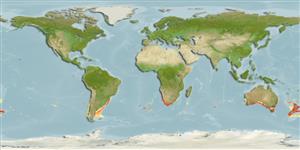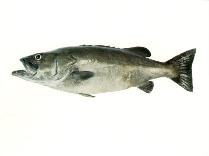Polyprion oxygeneios (Schneider & Forster, 1801)
Hapuku wreckfish
Adicionar sua observação em Fish Watcher
| Native range | All suitable habitat | Point map | Year 2050 |

|
| This map was computer-generated and has not yet been reviewed. |
| Polyprion oxygeneios AquaMaps Data sources: GBIF OBIS |
Carregue seu(sua) Fotos e vídeos
Pictures | Stamps, coins, misc. | Imagem do GooglePolyprion oxygeneios
Picture by SeaFIC
Pictures | Stamps, coins, misc. | Imagem do GooglePolyprion oxygeneios
Picture by SeaFIC
Common names from other countries
Classificação / Names Nomes comuns | Sinônimos | Catalog of Fishes(Gênero, Espécies) | ITIS | CoL | WoRMS | Cloffa
> Acropomatiformes (Oceanic basses) > Polyprionidae (Wreckfishes)
Etymology: Polyprion: Greek, poly = a lot of + Greek, prion = saw (Ref. 45335).
More on authors: Schneider & Forster.
Etymology: Polyprion: Greek, poly = a lot of + Greek, prion = saw (Ref. 45335).
More on authors: Schneider & Forster.
Environment: milieu / climate zone / depth range / distribution range Ecologia
marinhas demersal; intervalo de profundidade 50 - 854 m (Ref. 52581). Subtropical; 28°S - 50°S, 180°W - 180°E
Distribuição Países | Áreas da FAO | Ecossistemas | Ocorrências | Point map | Introduções | Faunafri
Circumglobal in southern waters: (Ref. 7300): South Africa, Australia, New Zealand, Kermadec I., Desventuradas Is., Juan Fernandez Is., Chile, north to southern Brazil, Tristan da Cunha.
Comprimento de primeira maturação / Tamanho / Peso / Idade
Maturity: Lm 88.0 range ? - ? cm
Max length : 160 cm TL macho/indeterminado; (Ref. 89467); common length : 100.0 cm TL macho/indeterminado; (Ref. 9258); peso máx. publicado: 100.0 kg (Ref. 4537); idade máx. registrada: 60 anos (Ref. 41439)
Max length : 160 cm TL macho/indeterminado; (Ref. 89467); common length : 100.0 cm TL macho/indeterminado; (Ref. 9258); peso máx. publicado: 100.0 kg (Ref. 4537); idade máx. registrada: 60 anos (Ref. 41439)
Descrição suscinta Chaves de identificação | Morfologia | Morfometria
Espinhos dorsais (total) : 9 - 12; Raios dorsais (total) : 12; Espinhos anais: 3; Raios anais : 7 - 9.
A deepwater species, occurs in seamounts (Ref. 89357). Adults occur generally over rough ground from the central shelf (about 100 m) to the shelf edge and down to the upper slope. Juveniles are found in surface waters, perhaps school in association with drifting weed. Feed on barracouta and pilchards, in addition to various bottom-dwelling fish. Are primary gonochorists (Ref. 58421). Preyed upon by sperm whales (Ref. 9072). It is taken by droplining down to 400 m, and is sometimes seen in the trawled catch. Utilized fresh and frozen; can be steamed, fried, broiled, boiled, microwaved and baked (Ref. 9988). Severely overfished (Ref. 89357).
Ciclo de vida ou comportamento de acasalamento Maturidade | Reprodução | Desova | Ovos | Fecundidade | Larvas
Are primary gonochorists (Ref. 58421).
Referência principal
Upload your references | Referências | Coordenador : Sedberry, George | Colaboradores
Paxton, J.R., D.F. Hoese, G.R. Allen and J.E. Hanley, 1989. Pisces. Petromyzontidae to Carangidae. Zoological Catalogue of Australia, Vol. 7. Australian Government Publishing Service, Canberra, 665 p. (Ref. 7300)
Ameaça para os humanos
Harmless
Uso pelos humanos
Pescarias: espécies comerciais; peixe esportivo: sim
FAO(pescarias: produção; publication : search) | FIRMS (Stock assessments) | FishSource | Sea Around Us
Mais informação
Population dynamics
Parâmetros de crescimento
Max. ages / sizes
Length-weight rel.
Length-length rel.
Frequências de comprimento
Conversão de massa
Recrutamento
Abundância
Parâmetros de crescimento
Max. ages / sizes
Length-weight rel.
Length-length rel.
Frequências de comprimento
Conversão de massa
Recrutamento
Abundância
Life cycle
Reprodução
Maturidade
Fecundidade
Desova
Spawning aggregations
Ovos
Desenvolvimento dos ovos
Larvas
Dinâmica larval
Reprodução
Maturidade
Fecundidade
Desova
Spawning aggregations
Ovos
Desenvolvimento dos ovos
Larvas
Dinâmica larval
Anatomy
Área branquial
Brain
Otolith
Área branquial
Brain
Otolith
Physiology
Body composition
Nutrients
Consumo de oxigênio
Tipo de natação
Velocidade de natação
Visual pigments
Fish sound
Diseases & Parasites
Toxicity (LC50s)
Body composition
Nutrients
Consumo de oxigênio
Tipo de natação
Velocidade de natação
Visual pigments
Fish sound
Diseases & Parasites
Toxicity (LC50s)
Genetics
Genética
Heterozygosity
Hereditariedade
Genética
Heterozygosity
Hereditariedade
Human related
Aquaculture systems
Perfis para aquacultura
Estirpes
Ciguatera cases
Stamps, coins, misc.
Aquaculture systems
Perfis para aquacultura
Estirpes
Ciguatera cases
Stamps, coins, misc.
Ferramentas
Livro eletrônico | Guia de campo | Ferramenta auxiliar de frequências de comprimento | Ferramenta sobre a história de vida | Mapa de pontos | Classification Tree
| Catch-MSY |
Relatórios especiais
Checar Manutenção em Aquário | Checar Planilhas de Fatos sobre as Espécies | Checar Planilhas de Fatos sobre Aquicultura
Baixar XML
Fontes da internet
Aquatic Commons | BHL | Cloffa | BOLDSystems | Websites from users | Checar Observador de Peixes (FishWatcher) | CISTI | Catalog of Fishes(Gênero, Espécies) | DiscoverLife | ECOTOX | Faunafri | Fishtrace | GenBank(genoma, nucleotídeo) | GloBI | GOBASE | | Google Books | Google Scholar | Google | IGFA World Record | MitoFish | Otolith Atlas of Taiwan Fishes | PubMed | Reef Life Survey | Scirus | SeaLifeBase | Árvore da vida | Wikipedia(Ir para, procura) | World Records Freshwater Fishing | Registro zoológico
Estimates based on models
Preferred temperature (Ref. 115969): 8.6 - 16, mean 11.7 (based on 143 cells).
Índice de diversidade filogenética (Ref. 82804): PD50 = 0.8125 [Uniqueness, from 0.5 = low to 2.0 = high].
Bayesian length-weight: a=0.01072 (0.00765 - 0.01501), b=3.00 (2.90 - 3.10), in cm Total Length, based on LWR estimates for this species (Ref. 93245).
Nível Trófico (Ref. 69278): 4.5 ±0.77 se; based on food items.
Resiliência (Ref. 120179): Muito baixo(a), tempo mínimo de duplicação da população maior que 14 anos (tm=10-13; tmax=60).
Fishing Vulnerability (Ref. 59153): High vulnerability (59 of 100).
Climate Vulnerability (Ref. 125649): High to very high vulnerability (70 of 100).




